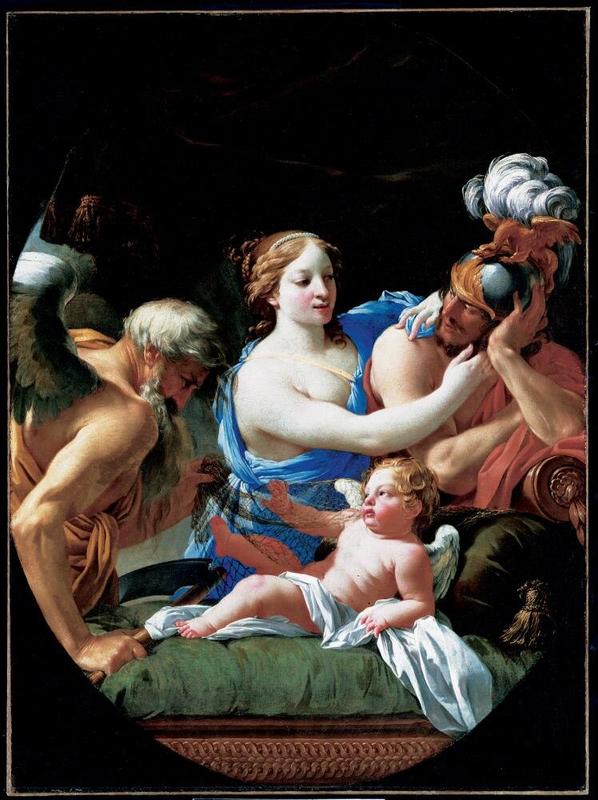More about Allegory with Venus, Mars, Cupid, and Time

Sr. Contributor
It’s fitting that Cupid came from a love affair, but it’s the Greek pantheon so it was also an adulterous and possibly incestuous one.
Venus, the Roman name for Aphrodite, was married to Vulcan (aka Hephaestus). Olympus was home to a number of unhappy marriages, all for various reasons, and theirs was no exception.
But all’s fair to the gods of love and war, so Venus and Mars (aka Aries), the god of war, fell for each other, madly. Vulcan started to catch on and obviously wasn’t a fan of the development. Though he really shouldn’t have been too surprised, forcing a woman to marry you against her will by asking the king of the gods to issue an official decree is not exactly a recipe for marital bliss.
So, Vulcan set a trap for them, literally ensnaring them in a metal net. You can spot the metal net in the painting, Chronos peeling it off of Cupid while Venus and Mars are too busy ogling each other to feel a lick of shame about the situation.
Our artist, Simon Vouet, was using the gods and what they represent in a complex allegory, as bluntly stated in the title. As to what the allegory actually is, well that’s up for debate. Some interpret the painting as Chronos/Father Time revealing Cupid to the world by removing the metal net from him. Thus the allegory referred to in the title would be along the lines of time revealing love.
But, Chronos also represents death, and in the painting he’s carrying his scythe and holding it way too close to a newborn, even if said newborn is an immortal god. So it can also be interpreted as Chronos not peeling off the net but instead placing it over Cupid to capture him. Seen this way, the title allegory would be referring to time vanquishing love and the net’s presence serves to foreshadow that his adulterous parents will be caught later on by Vulcan.
I’d prefer to lean toward the first interpretation but the scythe throws a wrench in that theory. Unless Chronos just carried it around all the time and no one in his long immortal life ever felt the need to explain the importance of keeping sharp objects away from newborns. The Greek gods were rather self-possessed, so that’s always possible.
On that note, the allegory could have a third interpretation if you focus on how irresponsible all the adults in the painting are being. Considering the parents are too lost in each other’s eyes to notice the scythe next to Cupid, the real overarching allegory is probably related to bad parenting. At least baby Cupid has wings so he can leave the nest early.
Sources
- "Aphrodite." Aphrodite, Goddess of Love, Beauty and Pleasure - Greek Gods. Accessed March 26, 2021. https://www.greek-gods.org/olympian-gods/aphrodite.php#:~:text=Divine lovers&text=Zeus married Aphrodite to Hephaestus,possess the goddess of beauty.
- "Aphrodite Loves 1." APHRODITE MYTHS 5 LOVES - Greek Mythology. Accessed March 25, 2021. https://www.theoi.com/Olympios/AphroditeLoves.html#:~:text=ARES The god of war,a short affair with Aphrodite.
- Rosenberg, Pierre. France in the Golden Age: Seventeenth-century French Paintings in American Collections. New York: Metropolitan Museum of Art, 1982.
- Time Discovering the Love of Venus & Mars. Accessed March 26, 2021. http://ringlingdocents.org/venus.htm.
- Vouet, Simon. "Allegory with Venus, Mars, Cupid, and Time." EMuseum. Accessed March 25, 2021.https://emuseum.ringling.org/emuseum/objects/27473/allegory-with-venus-…- cupid-and-time.











